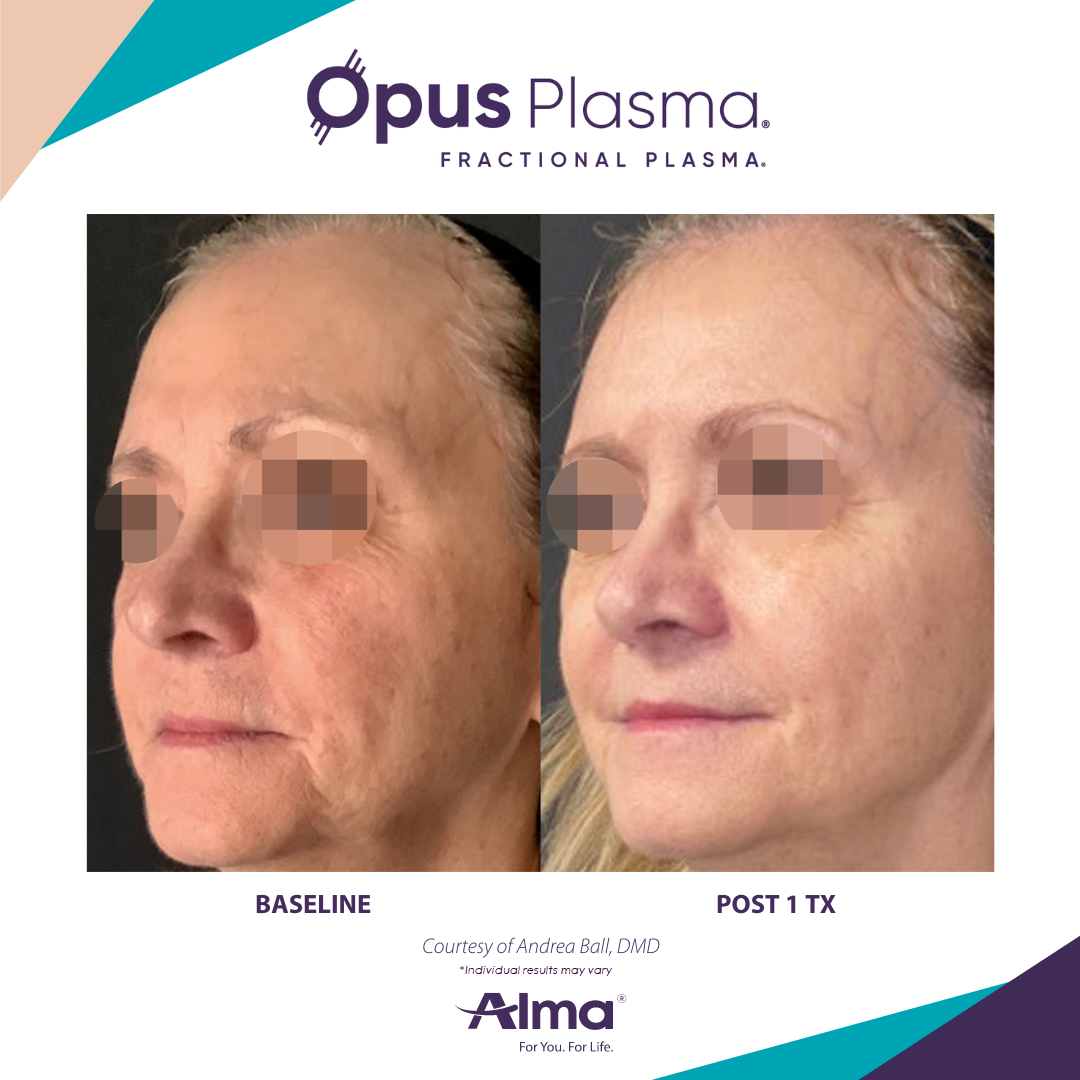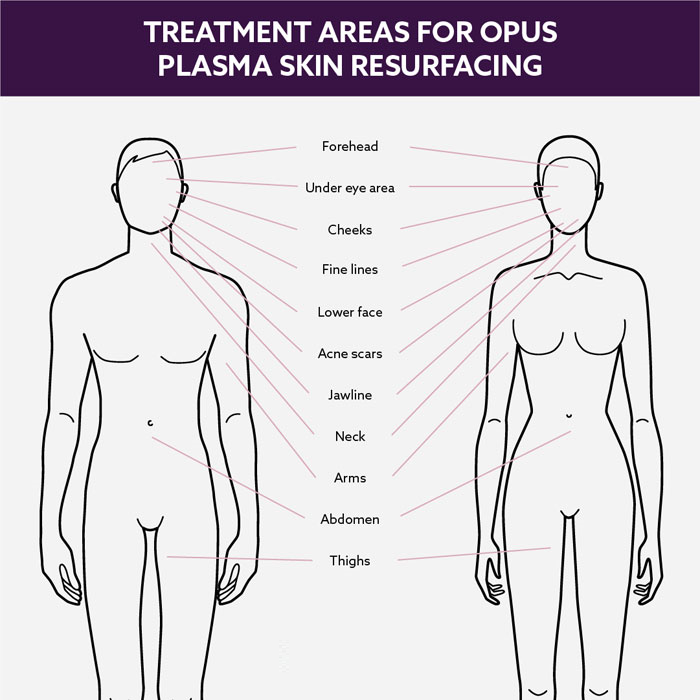ENHANCE SKIN QUALITY WITH NEW
FRACTIONAL PLASMA® TECHNOLOGY
IN THE SEWICKLEY AREA

A new type of skin resurfacing technology—one that’s more advanced than traditional ablative laser skin resurfacing or fractional laser techniques—is now available: Opus Plasma®.
The Sewickley area’s premier Ophthalmology practice and it's medical staff now provide this treatment, introduced to the North American aesthetic market in 2020, to address a wide variety of skin concerns, ranging from superficial to severe.
Why consider the Opus Plasma® platform from manufacturer Alma? Faces often begin to sag and wrinkle over time because they lose a small percentage of collagen each year that is not replaced. Collagen protein is one of the main building blocks in the skin. Additionally, older skin contains less fat and moisture while bone and muscle density decrease, so facial structure begins to weaken. Along with normal aging, day-to-day wear and tear from external sources like UV radiation in sunlight, gravitational forces, and air pollution can’t be completely avoided. There are also lifestyle habits—like smoking, eating unhealthy foods, and neglecting skincare routines—that take a toll on the face’s appearance over time.
WHAT IS OPUS PLASMA®?
In the past, lasers were one of the only tools available for creating a smoother, more even skin tone and addressing unwanted blemishes. As an advanced energy-based skin resurfacing system, Opus Plasma® uses a high-frequency unipolar radiofrequency technology, essentially combining radiofrequency with plasma. This FDA-cleared, non-laser device is the first ever skin resurfacing system that utilizes fractional plasma technology to create more youthful-looking skin and restore confidence.
Plasma, a new and innovative technology used for aesthetic treatments, is essentially an ionized gas that can be used to deliver heat directly to the skin in a controlled manner.
Opus Plasma® features radiofrequency-charged metal pins designed to create fractional injuries on specific areas of the skin. It operates at a high frequency of more than 40 MHz. Once the pins are near the skin, plasma is created in reaction to the atmospheric pressure, and this is what creates heat, stimulating regeneration of collagen, elastin, and hyaluronic acid.


*Individual results may vary
Plasma also has other benefits, such as neutralizing free radicals that cause premature aging and getting rid of bacteria as well as other harmful microbes. The effects enable skincare ingredients to be absorbed more easily into the skin.
Though it might seem counterproductive to improve skin by damaging it, the idea behind fractional resurfacing techniques like Opus Plasma® is to cause controlled damage and therefore kickstart a wound-healing response, gradually improving the general quality of the skin. Since the treatment targets only a fraction of the skin at a time—it opens tiny channels surrounded by unharmed, healthy tissue—there is less damage to other tissues with Opus Plasma®, which means it takes a shorter time to heal. The Opus Plasma® treatment has significantly less downtime compared to conventional laser treatments, while producing the same level of improvement as more invasive, ablative lasers.

Opus Plasma® at the Sewickley area’s Ophthalmology Associates of Osborne is a versatile skin rejuvenation treatment that blends fractional plasma technology and radiofrequency energy to repair photodamage and address signs of aging.
Sessions can quickly target a range of cosmetic conditions with consistent results, matching the intensity of the collagen-inducing energy to a
patient’s unique goals.
FAQ
-
WHAT IS THE DOWNTIME?
Downtime depends on you! If you want faster results and can tolerate more downtime, expect about 3-7 days for recovery—though most people can look presentable with good makeup after 24 hours. If you can’t tolerate a week of downtime, more treatments will be needed at lower settings. It’s very customizable.
-
HOW FAR APART DO YOU RECOMMEND THE TREATMENTS BE SCHEDULED?
2-4 weeks.
-
HOW MANY TREATMENTS ARE REQUIRED?
This depends on the treatment goal. You may see results after one treatment, however, typically 3 treatments are recommended to see optimal results. Treatments can be continued, 2-4 weeks apart, until satisfactory results are achieved.
-
HOW IS OPUS DIFFERENT FROM USING A CO2 LASER?
Very similar results but far less downtime and far less risk as it is Fractional Plasma meaning the device ablates small channels but leaves much of the epidermis intact because of this you can look presentable in as little as 24 hours with makeup and far less risk of infection (no oozing, minimal crusting, no bleeding).
-
WHAT PRODUCTS SHOULD I USE AFTER AN OPUS PROCEDURE?
After the Opus procedure, your skin is going to look and feel like it is badly sunburned—and just like a sunburn, you’ll want to keep it moist. There are many medical-grade post-procedure products available, and a couple products in particular that we will recommend after an Opus procedure. We always recommend staying very well hydrated, and if any area of the skin cracks, apply Aquaphor to protect that area and keep it moist. Stay out of direct sunlight, use an SPF of 40 or greater (reapply every two hours), and wear a sun hat and sunglasses, too.
WHICH CONDITIONS CAN OPUS PLASMA® TREAT?
There are certain types of cosmetic issues, such as spots and other pigmentation irregularities, that you can’t address with injectables like fillers. Opus Plasma® can correct hyperpigmentation. In addition, it tightens and repairs the skin to correct many other skin conditions, including fine lines and wrinkles, dullness, enlarged pores, broken blood vessels, skin laxity, acne scars, stretch marks, and uneven texture. It has the dual benefit of reducing unwanted pigmentation on the surface while also tightening sagging skin, including for a non-surgical eyelid lift.

Opus Plasma® is customizable and can be adjusted depending on the skin type and needs of the patient. It can be used on the face, neck, chest, or elsewhere on the body. There are two different types of pins available—depending on whether you’re targeting large or smaller areas—and there are three settings: light, moderate, and aggressive. The Opus Plasma® device is designed to allow for precision and is safe for sensitive, thinner areas around the eyes or on the lips.

WHAT IS THE OPUS PLASMA® EXPERIENCE AT OUR OFFICE?
Prior to having Opus Plasma®, it’s important to have a one-on-one consultation with our staff so that you can talk about your goals from aesthetic treatments. We can help you decide whether a fractional plasma treatment would be suitable for you. We will evaluate your overall health status, examine your face, and explain the various skin resurfacing options.
It’s important for patients to be upfront about any previous cosmetic treatments they have had. During the consultation, you can also ask any questions you might have about preparation and recovery.
The Opus Plasma® process itself is quick and simple: You can treat the entire face in around 15 to 20 minutes. A topical anesthetic is applied to the skin to reduce any discomfort, but know that a session typically only causes mild sensations of heat and pressure. Patients describe it as a 3-5 out of 10 on the pain scale.
Generally, since the Opus Plasma® device creates minimal inflammation, downtime should only be one to two days, and patients can resume their normal activities as soon as they are done, with the addition of a sun hat, sunglasses, and sunscreen applied every two hours. Although patients will notice visible improvements after the first session, at least two to three treatments may be needed for optimal results, as the skin looks increasingly better after each session. The results from Opus Plasma® may last up to several years, especially when patients have maintenance treatments and combine it with other skin rejuvenation options.
ARE THERE ANY SIDE EFFECTS FROM OPUS PLASMA®?
Opus Plasma® creates noticeable improvements with virtually no side effects. After having this fractional plasma treatment, most patients experience only temporary, mild to moderate redness and swelling that feels like a sunburn, as well as tight, dry-feeling skin.
We will provide specific aftercare instructions, but as a general rule, it’s usually best to avoid excessive sun exposure and keep your skin hydrated in the days following an Opus Plasma® session.
Contact us to schedule a FREE consultation:
Contact Us
We will get back to you as soon as possible
Please try again later
Contact Information
Phone: (412) 741-6776
Fax: 412.741.1390
Business Hours:
- Mon - Fri
- -
- Sat - Sun
- Closed
1099 Ohio River Boulevard Sewickley, PA 15143
Ophthalmology Associates of Osborne